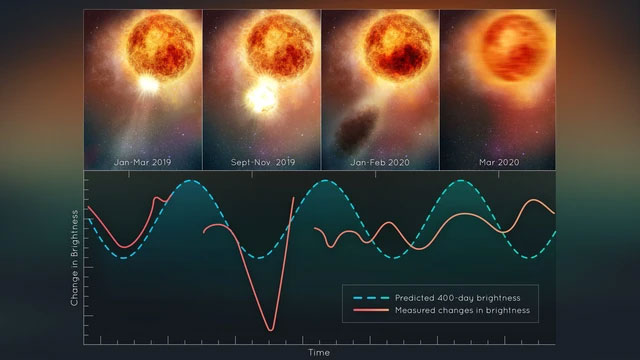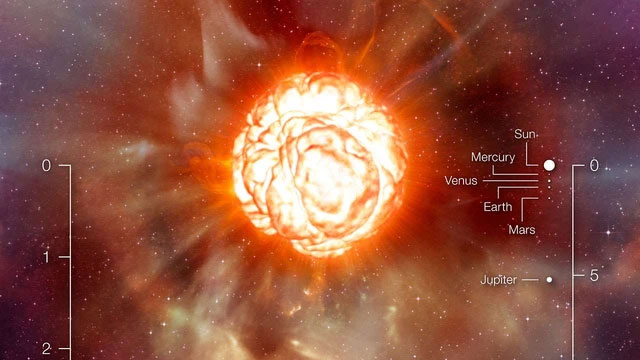Betelgeuse's Massive Threat: If It Explodes, Could It Swallow the Earth?
At the edge of the universe, the Betelgeuse star cluster burns quietly, famous for its enormous power and strange energy. However, the threat from this star cluster has scientists worried. The latest research results have finally been published, revealing the potential threat that Betelgeuse poses to Earth.
Betelgeuse's name comes from the constellation in which it is located - Ursa Major. Ursa Major is a common constellation in the northern hemisphere and is considered an important symbol in many ancient cultures. In traditional Chinese culture, Ursa Major is called the "Seven Stars of the Big Dipper" and is considered a symbol of auspiciousness and direction.
Betelgeuse is so bright that it stands out prominently in the night sky. Ancient navigators and explorers relied on its location to determine their routes and time. They knew that Betelgeuse's position changed with the seasons, which helped them gauge the passage of time.

Betelgeuse played an important role in ancient times as a timekeeper and countdown starter. Changes in its brightness and position helped people determine the passage of time and predict changes in natural phenomena.
In addition to its use in navigation and timekeeping, Betelgeuse is also associated with agriculture and predicting natural phenomena . Based on Betelgeuse's position and changes in brightness, farmers can deduce changes in nature. For example, when Betelgeuse is in a particular location, people know it is the beginning of the rainy season. When Betelgeuse disappears from the starry sky, it means that autumn has arrived.
However, with the advancement of technology, people gradually no longer rely on the stars to predict time. Modern science has developed methods to observe and predict time accurately, such as calendars and watches. People can easily obtain accurate time information through mobile phones or computers. Therefore, this function of Betelgeuse has been reduced to some extent.

Scientists are closely monitoring Betelgeuse's evolution and trying to predict its future fate.
Huge energy released from Betelgeuse explosion
Betelgeuse is a widely studied star system. It consists of four stars, three of which form a bright oblique triangle, while the fourth star lies slightly above it. The system has attracted great interest in the scientific community because of whether the enormous energy it releases will have an impact on Earth.
Betelgeuse is about 1,500 light-years from Earth , which means that what we observe of Betelgeuse actually happened 1,500 years ago. However, even light from the past reveals a beautiful picture.
The most prominent of these is the central star, Betugus . It is a very large and bright blue giant star that is considered a candidate for an imminent supernova. A supernova is the energy released when a star explodes, causing it to shine brighter than an entire galaxy of stars for a short period of time. If it exploded as a supernova, the release of energy would be an unprecedented event.

Despite being so far away from us, scientists have noticed that it has some impact on Earth. Over the past few decades, scientists have conducted extensive research to find ways to prevent Betelgeuse from having a negative impact on Earth.
However, some scientists point out that although supernova explosions release huge amounts of energy, this does not necessarily mean that Earth is in danger. Betugus is far enough away from Earth that even if a supernova were to occur, the effects of its radiation and shock waves would be greatly weakened by the time it reaches Earth. The Earth's atmosphere and magnetic field also act as a protective shield, minimizing the effects of cosmic radiation on us.
Even if the energy release has only a small impact on Earth, studying Betelgeuse is still important. By observing and analyzing the evolution of Betelgeuse, scientists can better understand the life cycles of stars and the laws of cosmic evolution. This is key to our understanding of the origin and future development of the universe.

With the continuous development of the latest technology, humans are trying to find ways to deal with the threat of Betelgeuse. One important technology is the development of space telescopes. By placing advanced telescopes in space, scientists can better observe and study the activities of Betelgeuse. They can monitor the changes in the stars and predict possible explosive activity. In this way, humans can take steps in advance to reduce the potential impact on the planet.
Studying Betelgeuse could also help uncover our own origins. Stars are considered one of the universe's greatest incubators of life, producing large amounts of important elements such as oxygen and iron through nuclear fusion. These elements are released into space when the star dies and eventually form Earth and other planets. Studying Betelgeuse could not only reveal the mysteries of the universe, but also help us understand our own existence.
The massive energy release from Betelgeuse will not pose a direct threat to Earth. However, it is still an extremely important star system and one worth studying. By studying Betelgeuse, scientists can gain a better understanding of the evolution of the universe and our own origins. Such research not only expands the boundaries of our knowledge, but also provides a solid foundation for future human exploration and development.
- Earth explodes with life thanks to 'threat from space'?
- Swallow and the basic information about swallow
- What will happen if we destroy the Moon?
- Swallow birds fly fast beyond imagination
- For the first time observing a giant star 'falling to death' in real time
- The 'monster' called the Fairy is about to swallow the galaxy containing the Earth
- Astronauts point out the danger that threatens the survival of mankind
- Shiver what can swallow the Earth right in the Solar System
- Can cars really explode after a collision like in the movies?
- Flying bird swallow: Model for modern aircraft
- 10 threats threaten the earth
- A celestial object explodes in the Earth's atmosphere
 Van Allen's belt and evidence that the Apollo 11 mission to the Moon was myth
Van Allen's belt and evidence that the Apollo 11 mission to the Moon was myth The levels of civilization in the universe (Kardashev scale)
The levels of civilization in the universe (Kardashev scale) Today Mars, the sun and the Earth are aligned
Today Mars, the sun and the Earth are aligned The Amazon owner announced a secret plan to build a space base for thousands of people
The Amazon owner announced a secret plan to build a space base for thousands of people